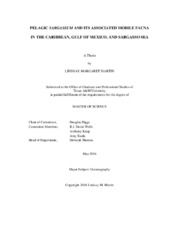| dc.description.abstract | There are many species of the genus Sargassum distributed in tropical and subtropical waters but only two, S. natans and S. fluitans, have an entirely pelagic life cycle and offer ecologically-supportive structures of different forms in otherwise nutrient-poor environments. Sargassum represents a keystone species supporting relatively high levels of biodiversity which is required for the maintenance of the health and resilience of a unique ecosystem currently facing many anthropogenic pressures. While studied for years, no simultaneous comparisons have been performed between the three regions in which Sargassum is most commonly found: the Gulf of Mexico, Caribbean, and Sargasso Sea. Dip-net Sargassum samples and associated macrofauna were collected from these three regions during the Spring/Summer of 2015 to examine differences in Sargassum species, structure, and faunal distribution. An unusually large abundance of the rare form S. natans VIII was seen in all three regions in addition to the more common forms of S. natans I and S. fluitans III. Isolated clumps and rows of Sargassum were equally common in all three regions while mats were comparatively rare. Sargassum from the Gulf, Caribbean, and Sargasso Sea shared five common (frequency >10%) species. Differences in the physical forms of Sargassum forms had a marked effect on fauna diversity and abundance. In all three regions, fewer individuals and species were found on the broad-leafed, less compact S. natans VIII than on the denser S. natans I and S. fluitans III. The majority of these species are benthic-like species that physically require the Sargassum substrate (unlike most fish), and therefore likely avoid loose S. natans VIII which offers less surface area and protection from predators. This study identifies the differences in macrofauna abundance and diversity between varieties of Sargassum and highlights the potential for dramatic community assemblage changes that could result from largescale Sargassum blooms and species shifts. | en |


